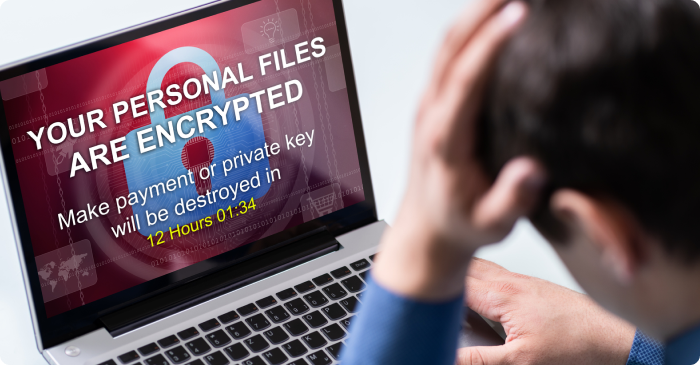Ransomware is a type of malware that is used by cybercriminals to extort money from their victims.
A typical ransomware attack works by a cybercriminal attacking the computer of the victim wherein the malware will encrypt a few files of the host.
Once the files have been encrypted, the host has no control over these files. The attacker then proceeds to threaten leaking the files or deleting them entirely with an average amount of ransom being 570,000$ in 2021, usually followed by a payment deadline.
After paying the ransom amount, which is usually requested in the form of Bitcoin, the attackers will hopefully give you a decryption key so that you can regain access to your files.
How can you deal with a ransom attack?
As with all types of cyberattacks, it is incredibly difficult to manage the attack once it occurs. One option is to outsmart the attackers in a ransom attack and decrypt the important files and transfer them to safe storage before the time runs out.
But the chances of that happening are very low, encryption is not easy to break quickly, or at all. The deadline given by the attackers is never enough to completely break the encryption. However, there are some steps you can take to try to minimize the negative effects of the attack.
Let’s take a look at them.
- Use a malware remover
If you are lucky and the attacker has used a simple ransomware, then you can try to just clean it up with a malware removal software. More complex ransomware is not that easy to remove, you will need to use an external drive to be able to scan the ransomware with a virus scanner.
- Identify the kind of ransomware used
If your attacker has used a pre-built ransomware to attack your system, then you can try to find a decryptor for it from available sources. You will most likely need to hire a cybersecurity expert to help with identifying the ransomware.
- Isolate the infected device
Once you have detected malware in your devices then you should immediately disconnect it from your LAN. This is done so that the virus cannot spread to other devices through the network.
The best cybersecurity policy you can have for your company is one that prevents attacks from occurring in the first place.
Now, these steps will only help in mitigating the effects of the attack. The success of these steps depends entirely on the type of ransomware used by the attackers.
If the attackers used an old and weak ransomware virus then you have a pretty good chance at fighting it off. But, you should never count on that. Cybercriminals have been getting more advanced and they have access to much more potent malware.
So, as with all cases of cyberattacks, prevention is always better than the cure. You should never take the threat of a cyberattack lightly and be well-prepared to deal with cyberattacks.
Here are some of the preventative steps you can take to be safe from ransomware attacks.
- Use Backups
The whole idea of a ransomware attack is that you lose access to files that contain important data. Your attackers will threaten to delete those files if the ransom is not paid in time.
However, something as simple as a backup can keep you safe from a ransom attack. Even if the attackers get to encrypt your files, you can just use your backup files to get back in business.
In that case, it doesn’t even matter if the attackers delete the files, backing up your files frequently means that you can continue with your regular work with minimal loss of data.
- Keep your software updated
Cybercriminals keep evolving and using newer tools, as their softwares get more advanced, so do the security softwares.
In order to be safe from the latest malware used by attackers, it is important that you keep your security software up to date. Older software is no longer effective against the threats of today.
- Watch out for those Emails!
According to Osterman Research, a whopping 59% of ransomware attacks come via email. This brings up the most important part of any cybersecurity policy. Training. You should ensure that your employees are properly trained to be able to identify potential sources of cyberattacks and avoid them entirely.
Even with the best cyber security softwares, frequent backups, and updated firewalls, all it takes for you to become the victim of a cyber attack is an employee who ignored clear signs of a potential cybercriminal.
Another thing to keep in mind is to have a great password policy in place for your firm.
Passwords often get leaked which leads to the company becoming an easy victim of a cyber attack.
You can learn how to develop a good password policy for your firm by reading this article.
